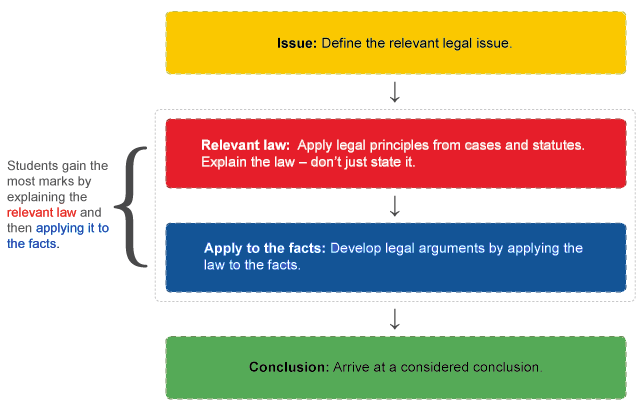The issue here is whether Gerald has rights to enforce.1Screen reader users, this is the issue. There are three sources of company law rights: the statute, the common law and the internal rules. As a matter of internal rights and obligations the parties need to turn to the internal rules. Without a constitution to provide internal rules, the corporate parties Rules. 202A (2) provides "the company may also pay the director's travelling and other expenses that they properly incur: ... (c) in connection with the company's business".2Screen reader users, this is the relevant law. This section provides discretion to the company regarding the payment of expenses. This means that the issue is a matter of private contract which is not addressed in the scenario.3Screen reader users, this is apply the facts. Accordingly, Gerald has no statutory remedy and no remedy arising from the internal rules.4Screen reader users, this is the conclusion.
Company law: Writing a legal scenario
This resource will help you to develop strategies for learning and remembering the course content and demonstrate a four-step technique for writing case study answers.
Company law is a challenging course for students because it involves:
- difficult legal terminology
- complex and detailed content
- a particular writing style
- Identify the issue
- Relevant law - Here you need to explain the law not just state it; this could be sections/s of the Corporations Act or case law
- Application to the facts - the law is applied to the facts of the problem
- Conclusion
- Issue: Define the legal relevant issue.
- Relevant law: Apply legal principles from cases and statutes. Explain the law, don't just state it.
- Apply to the facts: Develop legal arguments by applying the law to the facts.
- Conclusion: Arrive at a considered conclusion.
IRAC structure
When answering a company law problem, it is useful to apply the IRAC structure so that you address all areas required. The IRAC method has four steps:
Use the following IRAC structure as a guide to answer case study questions.

Note: Students gain the most marks by explaining the relevant law and then applying it to the facts.
Example
Advise the directors. (This a five-mark question)
Answer
| Issue | The issue in this case is whether the corporate veil can be lifted. |
|---|---|
| Relevant law | The legal principle to apply, established in Saloman's case, is that a company is a separate legal identity from its directors and members. However, there are exceptions when the corporate veil can be lifted. In the case of Guildford Motor Co Ltd v Horne it was decided that the veil of incorporation can be lifted if a wholly owned subsidiary was set up by a company to avoid a legal obligation under contract. |
| Application to facts | In this case, it appears that Bingo Ltd set up the subsidiary company to avoid its contractual obligations to supply its goods exclusively to Melvin Ltd. |
| Conclusion | Therefore, the directors can ask the court to lift the veil of the wholly owned subsidiary of Bingo and sue Bingo for breach of contract. |
Please note: This is a simple low mark answer (5 marks) to illustrate the use of IRAC only. Many Company Law problems will involve multiple issues. In these scenarios each issue would need to be addressed. For example: The first issue is... The second issue is whether...
Activity 1
Now read the following text and try to identify the IRAC structure. Check your understanding by opening the Activity 1 answer accordion folder.
The issue here is whether Gerald has rights to enforce. There are three sources of company law rights: the statute, the common law and the internal rules. As a matter of internal rights and obligations the parties need to turn to the internal rules. Without a constitution to provide internal rules, the corporate parties Rules. 202A (2) provides "the company may also pay the director's travelling and other expenses that they properly incur: ... (c) in connection with the company's business". This section provides discretion to the company regarding the payment of expenses. This means that the issue is a matter of private contract which is not addressed in the scenario. Accordingly, Gerald has no statutory remedy and no remedy arising from the internal rules.
Screen reader users, this text uses visual highlights to indicate different features of the text. Each highlight is explained for your convenience.
Activity 2
Read the following question, then identify which part of the IRAC structure best fits each text excerpt by selecting from the drop down menus.


